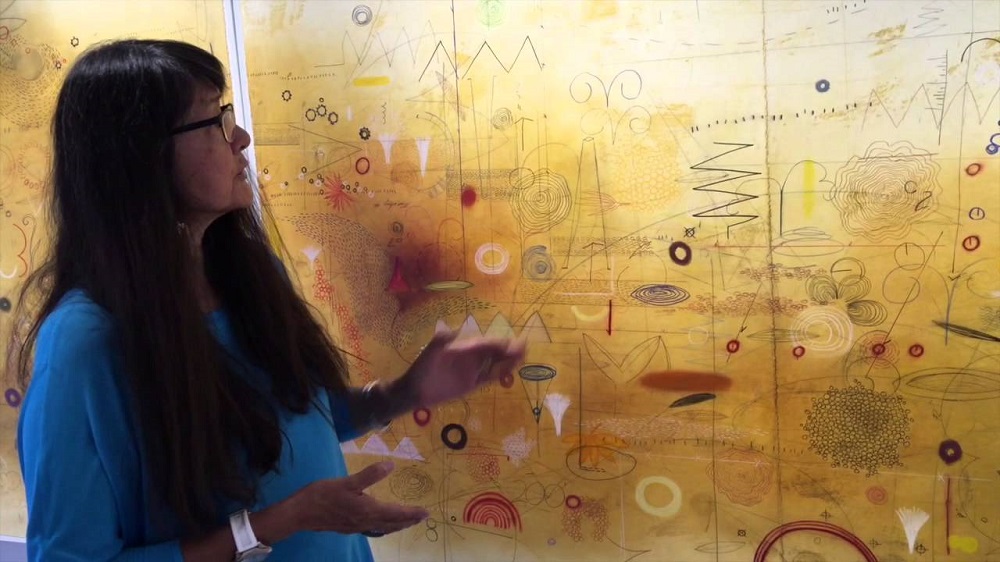
Emmi Whitehorse talks about her painting “Outset, Launching, Progression” at Chiaroscuro Gallery in Santa Fe, NM, 2015
November is Native American Heritage Month in the United States. To celebrate, we will be appreciating the work of some of the Native American artists in our collection throughout the month.
Born in Crownpoint, New Mexico in 1957, Emmi Whitehorse grew up in a Navajo (Diné or Naabeehó) family living in the realm of Chaco Canyon. Whitehorse’s rearing was founded in traditional Navajo living and philosophy, along with a deep connection to the changing of seasons and the land of her ancestors. In the winter her family lived indoors, while during warmer seasons they would live outside.

Outset, Launching, Progression (2015)
Emmi Whitehorse Native American, born 1957
overall: 51 in. × 19ft. 6 in. (129.5 × 594.4 cm)
each panel: 51 × 78 in. (129.5 × 198.1 cm)
Oil on paper mounted on canvas
Crystal Bridges Museum of American Art, Bentonville, Arkansas
Crystal Bridges recently acquired a large, three-panel painting created by Whitehorse in 2015 titled Outset, Launching, Progression (seen above). The artist began creating large-scale work under the encouragement of her professor, Harmony Hammond, while studying art at the University of New Mexico. This painting in particular was ground-breaking – no pun intended – within Whitehorse’s oeuvre because of its expression of her political stance against fracking.
Fracking is a means of sourcing natural gases or oil by drilling pipes deep underground and displacing the natural gas by pumping in liquids at high pressure. A heavily industrial process, it has been protested by environmental groups and has been linked with increased earthquake activity. Prior to this painting’s creation, a fracking company had come into Whitehorse’s homeland and displaced many families from their homes. The panels of Outset, Launching, Progression reflect the steps and methods Whitehorse witnessed before, during, and after the company came to New Mexico.
Despite the destructive subject matter of the imagery, Whitehorse stays true to her beliefs that an imbalance in the body and mind can be healed through a deeper connection with beauty and nature. Her painting style in the three-part landscape illustrates her ability to maintain aesthetic pleasure, even while dealing with difficult subjects. The range of gradients and tones recall the activity of the sun over the earth from dawn to dusk, while swirl markings reference the topography of the earth’s surface.
The panels are meant to be read from left to right, representing the state of the land prior to fracking, the process of digging and preparation, and the result of the fracking upon the land. Whitehorse wanted the painting to require close inspection and draw attention to what was happening on Navajo lands.
If you’d like to hear the artist speak about this particular work in greater detail, follow this link.
From the artist’s statement:
“…My work is about and has always been about land, about being aware of our surroundings and appreciating the beauty of nature. I am concerned that we are no longer aware of those. The calm and beauty that is in my work I hope serves as a reminder of what is underfoot, of the exchange we make with nature. Light, space and color are the axis around which my work evolves. The act of making art must stay true to a harmonious balance of beauty, nature, humanity, and the whole universe. This is in accordance with Navajo philosophy.”

Artist Emmi Whitehorse at work in the studio. Courtesy Segura Gallery.
Outset, Launching, Progression is not currently on view, at Crystal Brdiges. However, numerous Navajo artists and members of more than 25 other Native American nations will be showcased in Native North America (working title), an exhibition organized by Crystal Bridges, which will debut at the museum in October, 2018.



